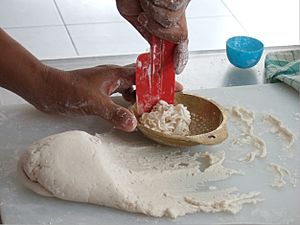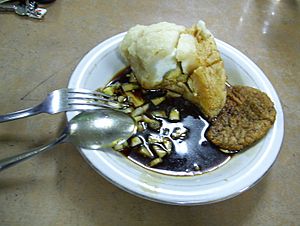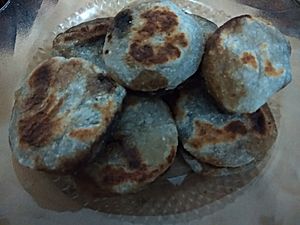Pempek facts for kids

Pempek kapal selam and keriting poured with kuah cuko; a sour, sweet and spicy sauce.
|
|
| Course | Main course or snack |
|---|---|
| Place of origin | Indonesia |
| Region or state | Palembang, South Sumatra |
| Serving temperature | Hot |
| Main ingredients | Fish cake from mixture dough of fish and tapioca, egg, noodle, palm sugar, vinegar and tamarind, dried shrimp powder |
| Variations | Lenggang, Tekwan, Model, or Rujak Mie. |
Pempek, also known as mpek-mpek or empek-empek, is a yummy Indonesian fishcake. It's made from fish and tapioca flour. This special dish comes from Palembang, a city in South Sumatra, Indonesia.
Pempek is usually served with a rich sweet and sour sauce. This sauce is called kuah cuka or kuah cuko, which means "vinegar sauce". Sometimes, people in Palembang also enjoy pempek with yellow noodles. They might add diced cucumber too. This helps to balance the sour taste of the vinegar sauce.
Contents
The Story of Pempek: Where Did It Come From?
Pempek is the most famous dish from Palembang. Everyone agrees it started there. But exactly how it began is a bit of a mystery! Some old stories say it has Chinese roots. Others think pempek might have come from an ancient dish called kelesan. This dish was made from sago dough and fish. It might have existed as early as the 7th century, during the Srivijayan era. Sago flour comes from the trunks of sago or aren palm trees.
The Old Chinese Man's Tale
One popular story goes like this: Around the 16th century, an old Chinese man lived near the Musi River. He saw that local fishermen caught lots of fish. Back then, there were no refrigerators. So, many unsold fish would go bad and be wasted.
Local people didn't know many ways to cook fish. They usually just grilled, fried, or boiled it. The old Chinese man had a clever idea. He mixed some tapioca flour and spices with the fish. Then, he sold this new dish from his cart around the village. People started calling him 'pek-apek'. Apek is a Chinese slang word for an old man. That's how this tasty food became known as empek-empek or pempek.
Another Idea: Chinese Influence
Another idea is that pempek is Palembang's version of a Southern Chinese dish. It might be like ngo hiang or kekkian (fish slice). These are foods made from surimi (fish paste). But pempek is special because of its unique sweet, sour, and spicy sauce. This sauce is made from palm sugar and vinegar.
What's in Pempek?
Making the Dough
The main part of pempek is its dough. It's made from ground fish meat without bones. The most common fish used is tenggiri (wahoo). This fish is mixed with water, salt, and sago flour. Sometimes, a little cooking oil or wheat flour is added. This makes the pempek less chewy and gives it a better texture. Some also add MSG to make the umami taste richer.
Ikan gabus (snakehead) is also often used. The best-tasting pempek is traditionally made from belida or belido (Chitala lopis). But this fish is rare, so pempek made from it is usually more expensive. In Bangka Island, pempek is made from mackerel (ikan kembung). Its sauce is red chili-based. In other cities like Jakarta, gourami fish might be used. There's even a newer type called pempek udang. This one is made from minced shrimp and has a pinkish color. It comes from the Sungsang area near the Musi River.
The dough is first boiled in hot water or steamed. This makes it partly cooked and firm. It's then stored and later fried just before serving.
The Special Sauce: Kuah Cuko
The kuah cuko sauce is very important for pempek. It's made by adding palm sugar, chili pepper, garlic, vinegar, and salt to boiling water. This gives the sauce a dark brown color. Sometimes, Tongcai and Ebi (ground dried shrimp) are added for more flavor.
This sweet, sour, and spicy sauce is key. The pempek dough itself is only mildly savory. The sauce from Bangka is different. It's chili-based, made from ground red chili and vinegar, and is bright red. Traditionally, all pempek sauces were hot and spicy. But now, many places offer separate chili paste (sambal) so you can choose how spicy you want it. In some restaurants, bottles of kuah cuko are on the tables. You can pour as much as you like! They often have both spicy and plain versions.
How Pempek is Served
Before serving, the boiled or steamed pempek pieces are deep-fried. They are fried in cooking oil until they turn a light pale brown. Then, they are cut into bite-sized pieces. Pempek is served with yellow noodles or rice vermicelli. It's covered in kuah cuko and sprinkled with chopped cucumber and ebi powder. Sometimes, fish krupuk crackers are offered on the side.
Different Kinds of Pempek
The basic fishcake dough can be shaped in many ways. Each shape has its own name, even though they all come from the same dough. Here are some popular types:
- Pempek kapal selam: This means "submarine pempek." It's made by wrapping a chicken egg inside the pempek dough. Then, it's deep-fried. It looks like a large Chinese dumpling. Scientists say this type is very nutritious. It has lots of protein, fat, vitamin A, minerals, and carbohydrates. Its name comes from its shape, which looks like a small submersible submarine.
- Pempek telur kecil: This is "small egg pempek." It's like pempek kapal selam but smaller.
- Pempek lenjer: This is a long, cylinder-shaped pempek. It looks a bit like a sausage. It can also be served as a big cylinder.
- Pempek keriting: This means "curly pempek." The dough is shaped into a small noodle ball. A similar process is used to make white krupuk.
- Pempek pistel: This type looks like pempek telur kecil. But instead of egg, it's filled with minced young papaya.
- Pempek kulit: This is "skin pempek." The dough is mixed with minced fish skin. This gives it a stronger fishy smell and a darker color.
- Pempek adaan: This pempek is shaped like a ball.
- Pempek tahu: This is tofu slices filled with pempek dough.
- Pempek tunu: This pempek is grilled over charcoal. It's stuffed with ebi, sweet kecap (soy sauce), and chili sauce.
- Pempek model (model iwak): This is fried pempek dough filled with tofu. It's like pempek kapal selam, but with tofu instead of egg. It's served in a shrimp soup, not cuko.
- Pempek uyen/bujan: This is a curly pempek from Bangka. It's made from taro and fish.
Most of these pempek types are deep-fried until light brown. They are served with yellow noodles or rice vermicelli and kuah cuko. Chopped cucumber and ebi powder are sprinkled on top.
Other Dishes Using Pempek
The unfried cylindrical pempek lenjer can also be cut and added to other dishes:
- Celimpungan: Small pempek balls cooked in spicy coconut milk. It's served with chili and sprinkled with bawang goreng (fried shallots).
- Laksan: This is like Palembang-style pempek in laksa soup. Sliced pempek fishcake is served in a coconut milk-based soup.
- Lenggang: An omelette mixed with sliced pempek fishcake. It's also served with kuah cuko.
- Tekwan: A soup with chopped pempek fishcake, jicama, mushroom, and fishballs.
- Model: Fried pempek dough filled with tofu. It's served with shrimp broth.
Where to Find Pempek
Since pempek is a local specialty, you can find it everywhere in Palembang. There are many shops in downtown Palembang. You can also find pempek in other big cities in Indonesia. However, the taste might be a bit different outside Palembang. This is because the special fish and flour used are harder to find elsewhere.
Pempek is easy to find in Jakarta and other Indonesian cities. You can buy it at food courts in malls or from street vendors with carts. Cheaper versions sold by cart vendors usually use less fish and more tapioca. This makes them less flavorful. Pempek is also popular in Bandar Lampung, the capital city of South Sumatra's neighboring province. Some pempek shops, like Pempek Pak Raden and Pempek Bunga Mas, have opened branches in many food courts. In Jakarta, Pempek Megaria near the Metropole cinema is famous. It's one of the oldest pempek places in the city. You can also find good pempek in the Pasar Minggu market in South Jakarta. In Yogyakarta, Pempek Ny. Kamto near Malioboro street is a top spot.
Outside Indonesia, you can find pempek shops in Singapore, Malaysia, and Australia. Palembang is not far from Singapore and Malaysia. To keep the taste authentic, some shops import boiled, unfried frozen pempek. These come in vacuum packages directly from Palembang. These ready-to-cook pempek dumplings are also popular gifts or souvenirs (oleh-oleh) for visitors to Palembang.
See also
 In Spanish: Pempek para niños
In Spanish: Pempek para niños






